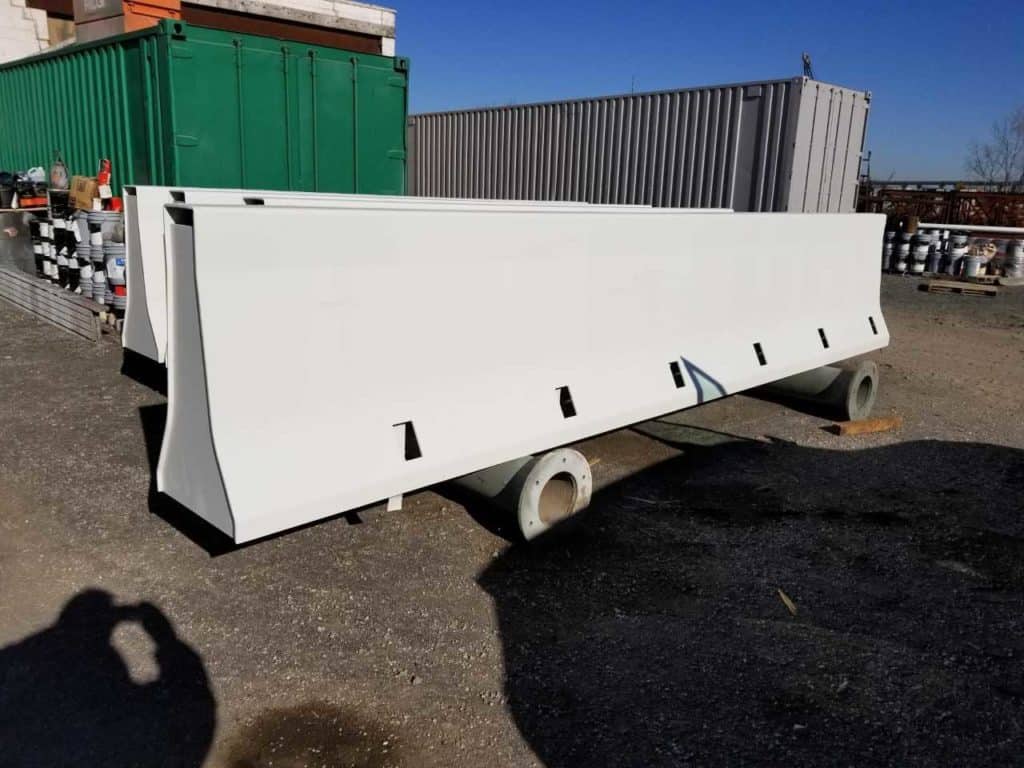Galvanizing is the application of a zinc layer to steel by a variety of methods such as hot dip, continuous or electro-deposition. In many instances galvanized steel is not painted since the service life of galvanizing alone typically exceeds that of conventional protective coatings. When paint is applied to galvanizing it often is referred to as a “duplex system.” The service life of a duplex coating system has been reported in studies to be a factor of 1.5 to 2.3 times the sum of the individual service lives for bare galvanizing or painting alone.[i] However, the actual increase in service life depends on the exposure environment; i.e., the duplex system in a mild exposure will have a longer service life than in a more severe exposure.
To achieve the expected long service life, proper preparation of galvanizing is critical. New galvanized steel has a smooth surface that inhibits coating adhesion. In addition, some post-treatments (discussed below) that frequently follow the galvanizing process may adversely affect coating performance.
Galvanizing Post Treatments
Galvanized steel is sometimes post treated or passivated to stop the reaction between the iron and zinc or to slow the subsequent oxidation (i.e. exposure to weathering) of the zinc surface. The most common post treatments are water quenching, chromate quenching and phosphating. In water quenching, freshly galvanized steel is dipped into a water bath to help accelerate the cooling process and stop the reaction between the iron and zinc. A consequence of water quenching is that the water often becomes contaminated with oil or dirt that gets deposited on the zinc surface. These contaminants can interfere with adhesion if they are not adequately removed prior to painting.
Chromate quenching is primarily used to prevent the formation of “white rust” or “wet storage stain” from occurring when galvanized steel is closely packed during transportation or storage. White rust refers to the zinc salts that naturally form on the galvanized surface as the zinc oxidizes during atmospheric exposure. Wet storage stain is an accelerated form of oxidation that takes place when higher concentrations of moisture and oxygen are trapped between pieces or sheets of galvanized steel that are closely stacked. Although the chromate treatment can prevent this oxidation, it can also interfere with adhesion if paint is later applied. Chromate treatment may be desired if painting is not intended after galvanizing, as the treatment typically results in a more uniform appearance as the zinc surface oxidizes and weathers. The “shiny” and “spangled” appearance of new galvanizing typically becomes gray, duller and mottled with age.
Phosphating treatments on steel after galvanizing form a non-reactive zinc phosphate layer over the zinc surface. In this process, the galvanized surfaces are first cleaned and degreased, and then immersed in a phosphating solution. Phosphating prevents corrosion products from forming on the surface and promotes adhesion with a subsequently applied paint layer.
Weathering of Galvanizing
Corrosion products (white zinc salts) start to form on a zinc surface as soon as it is exposed to the environment. Generally, the initial zinc compounds that are formed are water soluble, porous and loosely adhered to the surface. Over time, these compounds are converted to a tightly adherent water insoluble film that serves to protect the zinc surface from further corrosion. Corrosion products are formed from the zinc reacting with atmospheric oxygen, carbon dioxide and water. The time to reach different weathering stages, however, varies greatly with the actual environmental exposure conditions in a particular location. The following categorizations of zinc “weathering” should be considered as average times.
Newly galvanized – less than 48 hours
No appreciable corrosion products are formed in the first 48 hours of galvanizing. Ideally, shop coating of the galvanizing should occur during this time period, if planned.
Partially weathered – 48 hours to 2 years
Oxidation of the surface begins as soon as zinc galvanizing is applied to steel. These oxidative products are relatively porous and loosely adhered to the steel surface during the early formation. Initially, zinc oxides and hydroxides that are water soluble form on the galvanized surface. This early corrosion product is sometimes referred to as white rust. As the zinc continues to weather, the initial corrosion products are slowly converted to water insoluble compounds consisting mostly of zinc carbonates.
Fully weathered – over 2 years
After an extended period, corrosion products are converted to a dense layer of zinc carbonates that are tightly adhered to the steel surface. This oxidized layer helps to protect the zinc from further corrosion.
If the application of a coating system is desired, the different stages of weathering dictate that separate surface preparation procedures be followed, depending on the age of galvanizing. Generally, painting galvanizing is divided into two categories– new galvanized and existing galvanized surfaces. Preparation of galvanized surfaces for paint application is further explored in a KTA University article by Kenneth Trimber titled, “Preparing Hot Dip Galvanizing for Painting – It’s not Overly Complicated.”
Painting New Galvanizing
The preparation of new galvanizing for painting assumes that a minimal period (less than 48 hours) has passed since galvanizing has occurred. However, the zinc surfaces may need additional cleaning if the material has been in storage prior to painting.
Freshly galvanized steel must first be cleaned and degreased in accordance with the SSPC-SP 1, Solvent Cleaning. This is particularly important if water quenching was used as a post treatment and dirt and/or oil residues were deposited on the surfaces. Additionally, new galvanizing intended for painting should not be chromate quenched. Any chromate compounds present on the galvanized surface will cause adhesion problems for subsequently applied coatings. If a chromate treatment was used, the surfaces must be thoroughly cleaned to remove the treatment and then tested for chromate compounds to ensure removal. Ideally, specifications for galvanized steel should not allow chromate treatment and instead should specify a phosphating post treatment. As previously described, phosphating produces a surface conducive to subsequently applied coatings. The phosphating passivates the zinc surface and produces a conversion coating layer that is ideal for the application of a coating system.
Following cleaning in accordance with SSPC-SP 1, new galvanized surfaces can be prepared for painting by application of a wash primer, chemical treatment or brush-off blast cleaning.
Wash Primers
One option for surface preparation consists of applying a wash primer to the cleaned galvanized surface. Wash primers are typically vinyl butyral-based materials that acid etch the galvanized surface to promote adhesion of coatings. The wash primer must be compatible with the intended coating system and care should be taken not to apply the primer any thicker than recommended, or cracking may occur. It should be noted that VOC (volatile organic compound) compliance of wash primers must be considered. Many wash primers may not meet the Federal, State or Local VOC content limits for shop or field application.
Chemical Treatments
Another option is chemical treatment using mildly acidic or basic solutions that etch the zinc surface. These products may be referred to as “pre-paint cleaners” and should be specifically designed for use on galvanizing. Pre-paint cleaning products are typically diluted with water, applied to the galvanized surface, and allowed a short dwell time. Although rinsing the surface with water is usually needed to remove any cleaner residues, there are some “no rinse” cleaners available.
Brush-off Blast Cleaning
Brush-off blast cleaning can also be used to prepare galvanized surfaces for coating. However, an obvious concern is that blast cleaning can damage and even remove a significant portion of the protective zinc layer if not properly controlled. Galvanized surfaces should be brush-off blast cleaned in accordance with SSPC-SP 16, “Brush-Off Blast Cleaning of Coated and Uncoated Galvanized Steel, Stainless Steels, and Non-Ferrous Metals.”
Painting Existing Galvanizing
As previously described, the age and exposure environment of the galvanized surface determines the stage of weathering. However, the procedures described in this section for “existing” galvanizing apply to all stages of weathering; the stage of weathering will determine the amount of cleaning necessary to achieve standard well-adhered coating. Note that these procedures are for bare, weathered galvanizing, and assume that paint has not previously been applied; however, the procedures would require only slight modification to address the removal of old, loosely adhered paint.
The preparation of existing galvanizing should include removal of dirt and other contaminants, loosely adhered zinc compounds, and all rust to result in a surface suitable for coating application. The first step should always be solvent cleaning per SSPC-SP 1 to remove contaminants such as dirt, oil, or grease. Testing for chromate or other post treatments may also be performed, although it is unlikely that problems from post treatment will still be present on fully weathered galvanizing. Subsequent surface preparation is most commonly achieved by pressurized water cleaning.
Pressurized Water Cleaning
Pressurized water cleaning is the preferred cleaning method for existing galvanizing since it has a lower potential of damaging or removing the galvanized layer versus other methods (e.g., abrasive blast cleaning or power tool cleaning). Although it is necessary to clean the galvanized surface for painting, the zinc layer should remain intact since this is what provides galvanic protection to the steel.
All surfaces should be cleaned in accordance with SSPC-SP WJ-4 /NACE WJ-4, “Water Jet Cleaning of Metals – Light Cleaning,” using pressurized water from 3,000 to 5,000 psi. The water pressure and cleaning stand-off distances should be adjusted as necessary to achieve the specified level of cleaning while minimizing damage to the protective zinc layer. The pressurized water will remove loose corrosion material, soluble salts, and other contaminants. Supplemental cleaning using hand or power tools may be necessary if rusting of the underlying steel has occurred.
Coating Systems
There are various coating systems that have a successful performance history on galvanizing. The typical systems include acrylic coatings, epoxy/polyurethane coatings, or moisture-cure urethanes. A corrosion resistant or zinc-rich spot primer is commonly recommended for touch-up of bare rusted areas on existing weathered galvanized steel prior to full coating.
It is important to note that alkyd (oil-based) coatings should not be applied to galvanizing due to the potential for reaction between alkaline zinc corrosion products (white rust) and the alkyd resin of the coating. When this occurs, the coating will often degrade (saponify) and fail.
Another option for new galvanizing is the use of shop-applied powder coating. Powder coatings are applied by electrostatic spray or by fluidized beds, making the process much more specialized compared to typical spray applied liquid coatings. The powder is deposited and held to the metal surface by the electrostatic charge and then baked at high temperatures to melt and fuse the powder into a solid coating film. Powder coatings for weathering exposures are typically polyester based materials such as triglycidylisocyanurate or TGIC, but epoxy powder coatings are also widely used on buried pipe (e.g. piping for gas and oil distribution). Powder coatings offer excellent adhesion, high abrasion resistance, low VOC emissions and little material loss. Polyester powders also offer excellent weathering characteristics (color and gloss retention). A concern when using powder coatings over galvanizing is the potential for outgassing during the film formation and curing process, causing pinholes in the finished coating surface. This can be minimized by pre-baking the galvanized component prior to powder coating.
- [i] van Eijnsbergen, J. F., “Duplex Systems,” Elsevier 1994, New York, NY, pp. 7-8




Really very useful one and interesting……Thank you sir as such kind of article learnt for my knowledge.